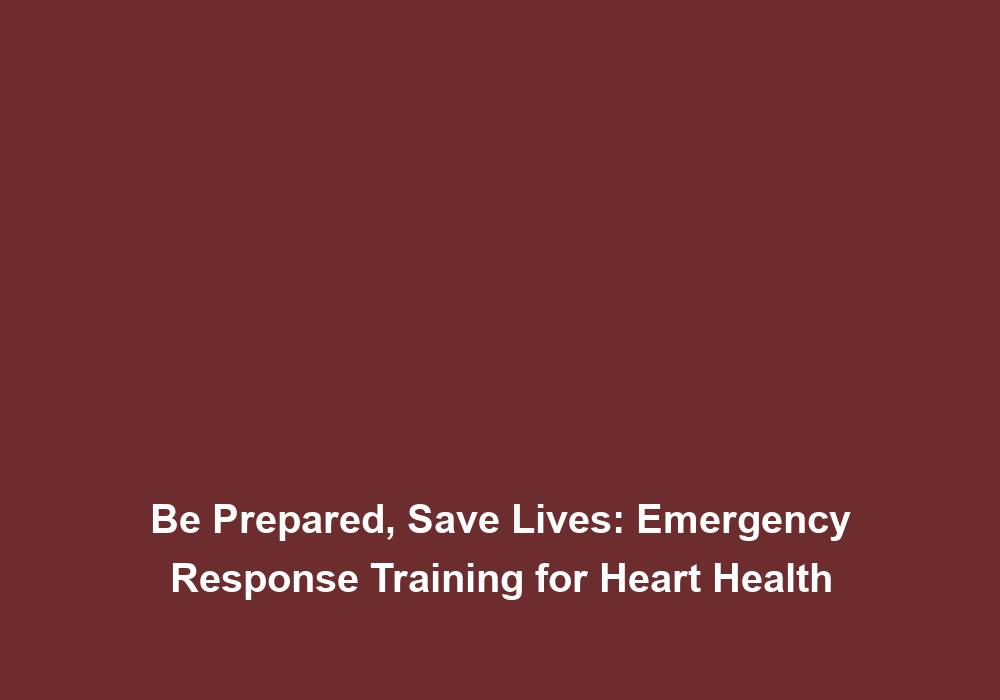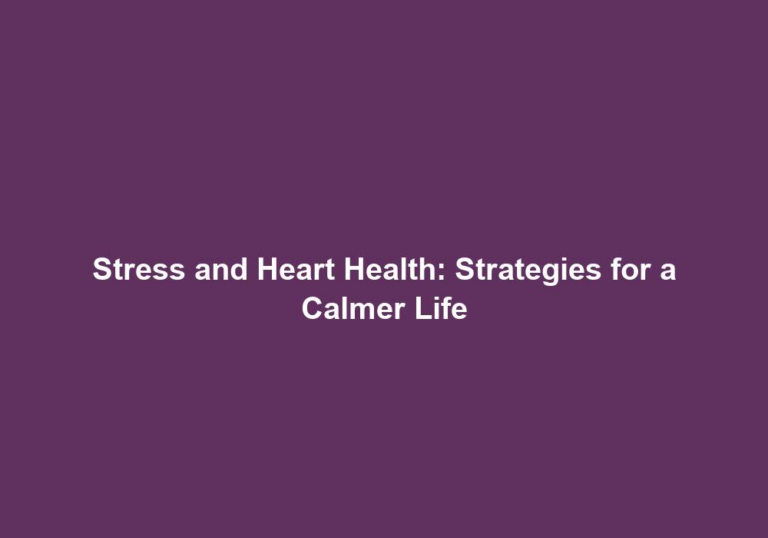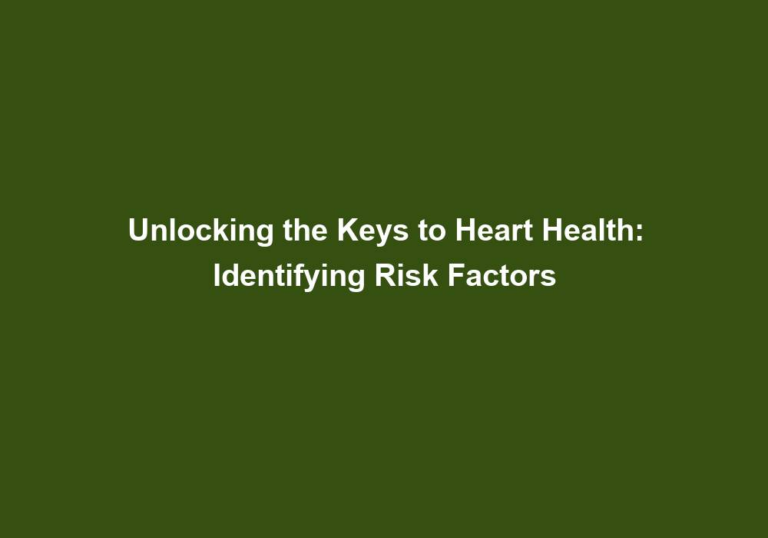Be Prepared, Save Lives: Emergency Response Training for Heart Health
Heart health is of utmost importance, as cardiovascular diseases continue to be a leading cause of death worldwide. In critical situations, knowing how to respond promptly and effectively can make a significant difference in saving lives. Emergency response training equips individuals with the necessary skills and knowledge to handle cardiovascular emergencies, such as heart attacks, cardiac arrests, and other related conditions. In this article, we will explore the importance of emergency response training for heart health and highlight some key aspects to consider.
Why is Emergency Response Training Important for Heart Health?
-
Immediate Action Saves Lives: During a heart-related emergency, every second counts. The ability to deliver immediate and appropriate care can significantly increase the chances of survival. Emergency response training provides individuals with the skills to recognize the signs of a heart attack or cardiac arrest and take swift action, including performing CPR (Cardiopulmonary Resuscitation) and using automated external defibrillators (AEDs).
- It is crucial to act quickly in a heart-related emergency to prevent further damage to the heart and increase the chances of survival.
- Emergency response training teaches individuals how to recognize the signs of a heart attack, such as chest pain or discomfort, shortness of breath, and sweating.
- By knowing how to perform CPR and use AEDs, trained individuals can effectively provide immediate care to someone experiencing a heart-related emergency.
-
Empowerment and Confidence: Knowing how to respond in a cardiovascular emergency empowers individuals to take charge and potentially save a life. This knowledge boosts confidence and eliminates the fear or hesitation that might arise in such situations. Trained individuals are better prepared to handle these critical moments and provide prompt assistance until professional medical help arrives.
- Emergency response training instills a sense of empowerment in individuals, enabling them to take immediate action and potentially save a life.
- By being trained in emergency response, individuals gain confidence in their abilities to handle cardiovascular emergencies, reducing the likelihood of panic or hesitation.
- The knowledge and skills acquired through training enable individuals to effectively assess the situation and provide appropriate care, increasing the chances of a positive outcome.
-
Reduced Response Time: Waiting for emergency medical services to arrive can take crucial minutes. By the time they reach the scene, irreversible damage may have occurred. However, with emergency response training, individuals can start providing aid immediately, minimizing the time gap between the onset of symptoms and receiving medical attention.
- Immediate action is essential in heart-related emergencies to prevent further damage and increase the chances of survival.
- Emergency response training equips individuals with the skills to provide immediate care, reducing the time it takes for medical professionals to arrive.
- By minimizing response time, trained individuals can significantly impact the outcome of a heart-related emergency and potentially save lives.
-
Prevention and Risk Reduction: Emergency response training not only focuses on responding to emergencies but also on preventive measures. Participants learn about risk factors, lifestyle modifications, and the importance of maintaining a heart-healthy lifestyle. By understanding how to reduce the risk of heart disease, individuals can play an active role in preventing emergencies from occurring in the first place.
- Emergency response training provides individuals with valuable knowledge about the risk factors associated with heart disease, such as high blood pressure, smoking, and poor diet.
- Participants learn about lifestyle modifications that can reduce the risk of heart disease, including regular exercise, maintaining a healthy weight, and managing stress.
- By promoting a heart-healthy lifestyle, emergency response training empowers individuals to take preventive measures and reduce the likelihood of experiencing a cardiovascular emergency.
Key Steps in Emergency Response Training for Heart Health
1. Recognizing the Signs and Symptoms
To effectively respond to a heart-related emergency, it is vital to recognize the signs and symptoms promptly. Here are some common indicators that individuals should be aware of:
- Chest pain or discomfort: This may feel like pressure, tightness, or a squeezing sensation in the chest.
- Shortness of breath: Difficulty breathing or feeling like you can’t catch your breath.
- Nausea or vomiting: Feeling sick to your stomach or actually vomiting.
- Dizziness or lightheadedness: Feeling faint or like you might pass out.
- Sweating: Unusual or excessive sweating, often accompanied by other symptoms.
- Fatigue or weakness: Feeling unusually tired or having a lack of energy.
2. Activating Emergency Medical Services
Once the signs and symptoms of a heart-related emergency are identified, activating emergency medical services (EMS) is crucial. This step ensures that professional help is on its way while you provide immediate care. Dial the emergency number in your country and provide clear and concise information about the situation.
- When calling emergency medical services, provide accurate information about the situation, including the location and the symptoms the person is experiencing.
- Stay on the line with the operator and follow any instructions they provide.
- Remain calm and reassure the person experiencing the emergency that help is on the way.
3. Performing CPR (Cardiopulmonary Resuscitation)
Cardiopulmonary Resuscitation (CPR) is a life-saving technique that can be performed by trained individuals while waiting for medical professionals. Here are the basic steps for performing CPR:
-
Check for responsiveness: Tap and shout, “Are you okay?” to the affected person. If there is no response, the person is unresponsive, and CPR should be initiated.
-
Call for help: If there is no response, ask someone nearby to call emergency medical services. If you are alone, perform CPR for about two minutes before calling for help.
-
Begin chest compressions: Place the heel of your hand on the center of the person’s chest, interlock your other hand on top, and position yourself directly over the person. Push hard and fast at a rate of 100-120 compressions per minute, allowing the chest to fully recoil between compressions.
-
Deliver rescue breaths: After 30 compressions, open the person’s airway by tilting their head back and lifting the chin. Pinch their nose shut and give two rescue breaths, each lasting about one second. Continue cycles of 30 compressions and two breaths.
-
Continue CPR: Repeat cycles of 30 compressions and two breaths until professional help arrives or the person shows signs of recovery.
- It is important to perform CPR correctly to ensure effective circulation of blood and oxygen to vital organs.
- The compression rate and depth must be adequate to generate blood flow, while the rescue breaths provide oxygen to the person’s lungs.
- Continuous cycles of compressions and breaths should be maintained until professional help arrives or the person starts showing signs of recovery.
4. Utilizing Automated External Defibrillators (AEDs)
Automated External Defibrillators (AEDs) are portable devices that deliver an electric shock to the heart in cases of cardiac arrest. During emergency response training, individuals learn how to use AEDs effectively. Here are the general steps for using an AED:
-
Turn on the AED: Follow the device’s instructions to power it on.
-
Attach the pads: Place the pads on the person’s bare chest as indicated on the pads. One pad should be placed on the upper right side of the chest, and the other on the lower left side.
-
Analyze the rhythm: Once the pads are attached, the AED will analyze the heart’s rhythm. Ensure that no one is touching the person during this analysis.
-
Follow voice prompts: If the AED advises delivering a shock, ensure that everyone is clear of the person, and press the shock button as instructed. If no shock is advised, continue CPR until further instructions or professional help arrives.
- AEDs are designed to be user-friendly and provide clear instructions to individuals during a cardiac emergency.
- By following the voice prompts and correctly applying the AED pads, individuals can effectively deliver a shock to the heart if necessary.
- It is important to ensure the safety of those present by ensuring everyone is clear of the person before delivering a shock.
Conclusion
Emergency response training for heart health is instrumental in saving lives during critical situations. By recognizing the signs and symptoms, activating emergency medical services, performing CPR, and utilizing AEDs, trained individuals become essential first responders. Their immediate actions and knowledge contribute to reducing response times, increasing survival rates, and promoting heart-healthy lifestyles. Taking the initiative to participate in emergency response training can make a significant difference in saving lives and ensuring the well-being of individuals experiencing heart-related emergencies.







